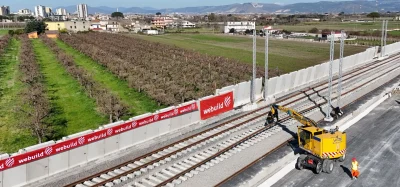First of new Stansted Express electric trains begin operation
Posted: 30 July 2020 | Global Railway Review | 2 comments
The first two of 12 new Stadler electric trains have begun operation on the Stansted Express route, marking the start of the final phase of the programme.


Credit: Greater Anglia
The first two of Greater Anglia’s brand-new Stansted Express trains have now entered passenger service between London Liverpool Street and Stansted Airport. The first journey to be operated by one of the new 12-carriage electric trains, built by Stadler, left London Liverpool Street for the airport at 05:06 on 28 July 2020.
Ian McConnell, Greater Anglia’s Franchise and Programmes Director, said: “We’re very pleased to have started the roll out of our new Stansted Express trains into passenger service. They provide significant benefits for both airport travellers and other customers travelling to or from London from stations such as Bishops Stortford and Harlow Town. This milestone marks the start of the final phase of the programme to introduce the new trains being built for us by Stadler.”
He continued: “All 38 bi-mode regional trains and 10 electric intercity trains are already in passenger service. Over the next six to nine months, we will replace all the current trains on the Stansted Express services with new trains, as part of our phased programme for bringing our new trains into service. As we do so, we will be able to progressively transfer the current Stansted Express trains on to other West Anglia services, enabling some of the older trains to be withdrawn from service. This means many more passengers will start to see the benefits of better trains, in advance of the introduction of our new commuter trains on West Anglia services, which is expected to begin in the latter half of 2021.”
The new, longer Stansted Express trains have 767 seats – representing an increase of 83 per cent on the 418 seats available on the eight-carriage trains currently operating the services. They also have plug and USB sockets, free and fast Wi-Fi, air conditioning and improved passenger information screens. Just as on Greater Anglia’s new bi-mode and intercity trains, they have gold standard accessibility features, including a lower floor and a retractable step at every door to bridge the gap between the train and platform. In every way, they offer a high quality travel experience for travellers between Stansted Airport and London Liverpool Street.
Managing Director for London Stansted Airport, Steve Griffiths, said: “The start of the introduction of brand new Stansted Express trains is fantastic news for all users of the service, including airport passengers, staff and local commuters as they travel between the airport and London, significantly enhancing the onboard journey experience and providing a real boost to our proud record as the UK’s number one airport for public transport use by passengers.”
Leandro Haggenmacher, Technical Project Manager for Stadler, said: “The start of the roll-out of trains for the Stansted Express route is a significant landmark as we enter the final stages of the project to supply 58 new trains for the Greater Anglia network. We are very pleased to have reached this point, recognising the important role Stansted Airport plays in the regional economy, boosting economic growth and supporting jobs.”
The Stansted Express trains are part of a £600 million investment in new Stadler trains for the region which have been financed by Rock Rail East Anglia and will be leased to Greater Anglia for the life of the franchise.
Related topics
Airport Rail Links, Electric/Hybrid Rolling Stock, Operational Performance, Passenger Experience/Satisfaction, Rolling Stock Orders/Developments, Sustainability/Decarbonisation, Wi-Fi
Related organisations
Greater Anglia, Rock Rail East Anglia, Stadler, Stansted Airport, Stansted Express








It is disgusting that these trains mean more pollution more waste and damage to the environment ugly overhead wires and gantries instead of more third rail as in the South of England, neat and efficient.
Third Rail although neater is old technology and at only 750 volts DC is not able to go faster than 100 mph unlike overhead AC traction which is also the European Standard Electric Traction in France, Germany, Spain and Italy